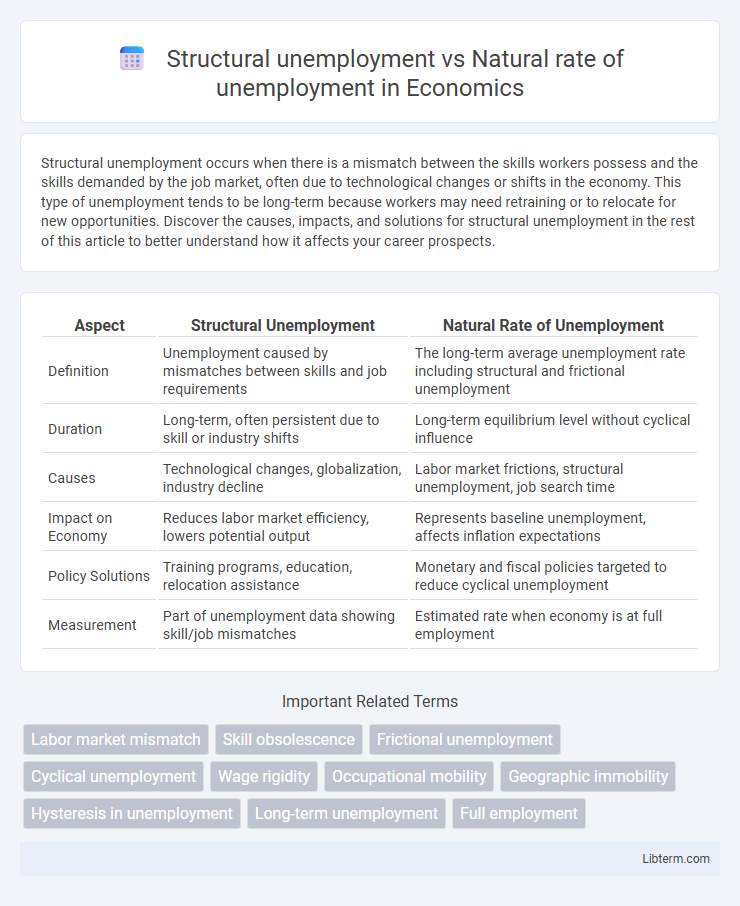Structural unemployment occurs when there is a mismatch between the skills workers possess and the skills demanded by the job market, often due to technological changes or shifts in the economy. This type of unemployment tends to be long-term because workers may need retraining or to relocate for new opportunities. Discover the causes, impacts, and solutions for structural unemployment in the rest of this article to better understand how it affects your career prospects.
Table of Comparison
| Aspect | Structural Unemployment | Natural Rate of Unemployment |
|---|---|---|
| Definition | Unemployment caused by mismatches between skills and job requirements | The long-term average unemployment rate including structural and frictional unemployment |
| Duration | Long-term, often persistent due to skill or industry shifts | Long-term equilibrium level without cyclical influence |
| Causes | Technological changes, globalization, industry decline | Labor market frictions, structural unemployment, job search time |
| Impact on Economy | Reduces labor market efficiency, lowers potential output | Represents baseline unemployment, affects inflation expectations |
| Policy Solutions | Training programs, education, relocation assistance | Monetary and fiscal policies targeted to reduce cyclical unemployment |
| Measurement | Part of unemployment data showing skill/job mismatches | Estimated rate when economy is at full employment |
Introduction to Unemployment Types
Structural unemployment occurs when there is a mismatch between workers' skills and job requirements, often due to technological changes or shifts in the economy. The natural rate of unemployment represents the long-term average level of unemployment expected in a healthy economy, including frictional and structural unemployment but excluding cyclical factors. Understanding these concepts is vital for designing effective labor market policies and addressing persistent unemployment challenges.
Defining Structural Unemployment
Structural unemployment occurs when a mismatch exists between workers' skills and the demands of the labor market, often due to technological advances or shifts in industry. It differs from the natural rate of unemployment, which includes frictional and structural unemployment but excludes cyclical unemployment caused by economic downturns. Understanding structural unemployment helps in addressing long-term labor market challenges and improving workforce adaptability.
Understanding the Natural Rate of Unemployment
The natural rate of unemployment represents the long-term average rate of unemployment arising from structural and frictional factors in a healthy economy, excluding cyclical fluctuations. It reflects the equilibrium where labor market supply equals demand, accounting for skill mismatches and job search processes. Understanding this rate is crucial for policymakers to differentiate between temporary unemployment due to economic downturns and persistent structural unemployment requiring targeted interventions.
Key Differences Between Structural and Natural Unemployment
Structural unemployment arises from mismatches between workers' skills and job requirements, often due to technological changes or shifts in the economy, whereas the natural rate of unemployment includes structural unemployment along with frictional unemployment and represents the long-term average unemployment rate when the labor market is in equilibrium. Structural unemployment tends to be persistent and requires retraining or relocation to resolve, while the natural rate fluctuates around a baseline influenced by labor market policies, demographics, and institutional factors. Unlike cyclical unemployment, which varies with economic cycles, understanding structural and natural unemployment is crucial for designing effective workforce development and macroeconomic policies.
Causes of Structural Unemployment
Structural unemployment arises from mismatches between workers' skills and job requirements caused by technological advancements, industry shifts, or geographic immobility. It differs from the natural rate of unemployment, which includes frictional and some structural unemployment, representing the baseline level when the labor market is in equilibrium. Causes of structural unemployment often involve automation, globalization, changes in consumer demand, and inadequate education or training systems.
Factors Influencing the Natural Rate of Unemployment
The natural rate of unemployment is influenced by structural factors such as labor market frictions, mismatches between workers' skills and job requirements, and demographic shifts impacting labor force participation. Changes in labor market policies, unionization rates, and technological advancements also significantly affect the natural rate by altering the ease with which workers find new jobs. Structural unemployment persists when long-term changes in the economy create disparities that prevent the labor market from clearing, thereby maintaining the natural rate above zero.
Economic Consequences of Structural Unemployment
Structural unemployment leads to prolonged joblessness due to mismatches between workers' skills and labor market demands, causing inefficiencies in resource allocation and reducing overall economic output. Its persistence increases the natural rate of unemployment, elevating the baseline level of joblessness even during economic expansions. High structural unemployment strains social welfare systems and depresses consumer spending, slowing economic growth and increasing income inequality.
Policy Responses to Structural and Natural Unemployment
Policy responses to structural unemployment emphasize retraining programs, investments in education, and regional development to align workers' skills with evolving job market demands. Addressing the natural rate of unemployment involves maintaining stable macroeconomic policies, promoting labor market flexibility, and supporting job search assistance to reduce frictional unemployment. Effective policies balance short-term relief measures with long-term strategies to adapt workforce capabilities and market conditions.
Case Studies: Real-World Examples
Structural unemployment persists in regions like Detroit's automotive sector, where shifts in technology and global competition have rendered many manufacturing jobs obsolete. The natural rate of unemployment in Scandinavian countries remains low due to strong labor market policies, social safety nets, and active workforce retraining programs. Case studies from Spain highlight high structural unemployment caused by skill mismatches and rigid labor regulations despite a declining natural rate driven by economic reforms.
Conclusion: Implications for Labor Markets
Structural unemployment highlights mismatches between workers' skills and job requirements, indicating the need for targeted retraining programs to align labor supply with demand. The natural rate of unemployment establishes a baseline reflecting frictional and structural factors, guiding policymakers in setting realistic employment goals. Understanding both concepts informs labor market strategies that promote workforce adaptability and long-term economic stability.
Structural unemployment Infographic

 libterm.com
libterm.com